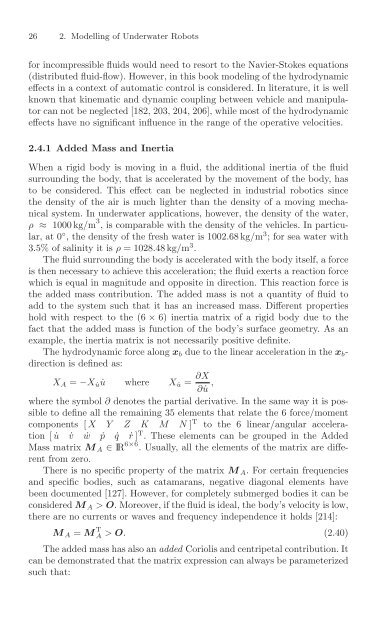Underwater Robots - Gianluca Antonelli.pdf
Underwater Robots - Gianluca Antonelli.pdf
Underwater Robots - Gianluca Antonelli.pdf
Create successful ePaper yourself
Turn your PDF publications into a flip-book with our unique Google optimized e-Paper software.
26 2. Modelling of <strong>Underwater</strong> <strong>Robots</strong><br />
for incompressible fluids would need toresort to the Navier-Stokes equations<br />
(distributed fluid-flow). However, in this book modeling of the hydrodynamic<br />
effects in acontext of automatic control is considered. In literature, itiswell<br />
known that kinematic and dynamic coupling between vehicle and manipulator<br />
can not be neglected [182, 203, 204, 206], while most of the hydrodynamic<br />
effects have no significant influence inthe range ofthe operative velocities.<br />
2.4.1 Added Mass and Inertia<br />
When arigid body is moving in afluid, the additional inertia of the fluid<br />
surrounding the body, that is accelerated by the movement ofthe body, has<br />
to be considered. This effect can be neglected in industrial robotics since<br />
the density ofthe air is much lighter than the density ofamoving mechanical<br />
system. In underwater applications, however, the density ofthe water,<br />
ρ ≈ 1000 kg/m 3 ,iscomparable with the density ofthe vehicles. In particular,<br />
at 0 ◦ ,the density ofthe fresh water is1002. 68 kg/m 3 ;for sea water with<br />
3 . 5% of salinity itis ρ =1028. 48 kg/m 3 .<br />
The fluid surrounding the body is accelerated with the body itself, aforce<br />
is then necessary to achieve this acceleration; the fluid exerts areaction force<br />
which isequal in magnitude and opposite in direction. This reaction force is<br />
the added mass contribution. The added mass is not aquantity offluid to<br />
add tothe system such that ithas an increased mass. Different properties<br />
hold with respect to the (6 × 6) inertia matrix of arigid body due to the<br />
fact that the added mass is function ofthe body’s surface geometry. Asan<br />
example, the inertia matrix is not necessarily positive definite.<br />
The hydrodynamic force along x b due to the linear acceleration in the x b -<br />
direction isdefined as:<br />
X A = − X ˙u ˙u where X ˙u = ∂X<br />
∂ ˙u ,<br />
where the symbol ∂ denotes the partial derivative. In the same way it is possible<br />
to define all the remaining 35 elements that relate the 6force/moment<br />
components [ X Y Z K M N ] T to the 6 linear/angular acceleration<br />
[˙u ˙v ˙w ˙p ˙q ˙r ] T .These elements can be grouped inthe Added<br />
Mass matrix M A ∈ IR 6 × 6 .Usually, all the elements of the matrix are different<br />
from zero.<br />
There isnospecific property ofthe matrix M A .For certain frequencies<br />
and specific bodies, such ascatamarans, negative diagonal elements have<br />
been documented [127]. However, for completely submerged bodies itcan be<br />
considered M A > O .Moreover, if the fluid is ideal, the body’s velocity islow,<br />
there are no currents orwaves and frequency independence it holds [214]:<br />
M A = M T A > O . (2.40)<br />
The added mass has also an added Coriolis and centripetal contribution. It<br />
can be demonstrated that the matrix expression can always beparameterized<br />
such that:






